The church Saint Nicolas's Day in Beaujeu
 When
the first lords were established on the rock of Pierre-Acute, at the
bottom of the small valley which Beaujeu occupies, extended, if one
believes a very probable tradition of it, a small lake. The way coming
from Belleville gained altitude by the mountainsides of Gonty
to arrive at the fortress of the lords. It is there, under the
protective walls of the castle, that Beaujeu starts to be born. The
construction of the Church of St-Nicolas, about 1130, created a new
point of attraction for the many craftsmen whom to Beaujeu his
situation brought on the main road of the Saone in the Loire. In, 1260,
the city obtained from Guichard IV the privileges similar to those
of Villefranche. Consequently it took a rapid development.
When
the first lords were established on the rock of Pierre-Acute, at the
bottom of the small valley which Beaujeu occupies, extended, if one
believes a very probable tradition of it, a small lake. The way coming
from Belleville gained altitude by the mountainsides of Gonty
to arrive at the fortress of the lords. It is there, under the
protective walls of the castle, that Beaujeu starts to be born. The
construction of the Church of St-Nicolas, about 1130, created a new
point of attraction for the many craftsmen whom to Beaujeu his
situation brought on the main road of the Saone in the Loire. In, 1260,
the city obtained from Guichard IV the privileges similar to those
of Villefranche. Consequently it took a rapid development.
The church Saint Nicolas's Day in Beaujeu
 It
is one of the most important Romance churches of the Beaujolais.
It is on February 12, 1132 that the church was devoted by the pope
Innocent II, come to France to seek a support against its candidate,
Antipape Anicet II (Pierre of Leon). Passing by Beaujeu, it devoted the
church and dedicated it to Saint Nicolas's Day, which was the owner of
the monastery of which he had been the Abbot.
It
is one of the most important Romance churches of the Beaujolais.
It is on February 12, 1132 that the church was devoted by the pope
Innocent II, come to France to seek a support against its candidate,
Antipape Anicet II (Pierre of Leon). Passing by Beaujeu, it devoted the
church and dedicated it to Saint Nicolas's Day, which was the owner of
the monastery of which he had been the Abbot.
 The
church had been rested by powerful Lord of Beaujeu, Guichard III.
The legend tells that the place where this church is established was a
pond. The son of prince Guichard III, coming back from hunting, there
desired to make drink its horse and fell inside and did not appear any
more; the news of this accident, if unexpected, being carried to
his mother, it dedicated to make build a church in the place
where his son appears, this wish was not rather stated a mouth of
this princess, that the prince wire was seen, to go up bottom of the
pond to the top, with the result that Guichard III made build the
church in the place where it is still present.
The
church had been rested by powerful Lord of Beaujeu, Guichard III.
The legend tells that the place where this church is established was a
pond. The son of prince Guichard III, coming back from hunting, there
desired to make drink its horse and fell inside and did not appear any
more; the news of this accident, if unexpected, being carried to
his mother, it dedicated to make build a church in the place
where his son appears, this wish was not rather stated a mouth of
this princess, that the prince wire was seen, to go up bottom of the
pond to the top, with the result that Guichard III made build the
church in the place where it is still present.
The Bell-tower
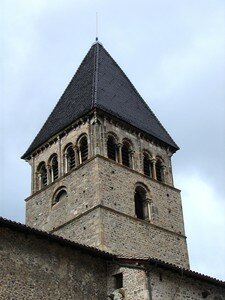 Imposing
by its antiquity, it is the oldest monument of the city. It is the clunisian
bell-tower in the shape of lantern, ending in a surmounted
cross of a cock. This kind was in honor in XIIth century.
Imposing
by its antiquity, it is the oldest monument of the city. It is the clunisian
bell-tower in the shape of lantern, ending in a surmounted
cross of a cock. This kind was in honor in XIIth century.
It is a
heavy square bell-tower with three floors: the higher stage is bored on
each face of two windows with semicircular arch whose interior
repercussion of the archivolts comes to rest on a solid mass of three
posts laid out in half-quincunxes; the repercussion external of the
archivolts is done on confined jambs each one of a post. The two groups
of coupled windows are separated by an imbedded column which, resting
on the cord from where the stage rises, will support the cornice of the
arrow. The vertical edges of the bell-tower are confined themselves,
each of the two posts. The median stage has only one window deadened in
semicircular arch on confined jambs of posts. The lower stage, very
low, is blind.
The Nave
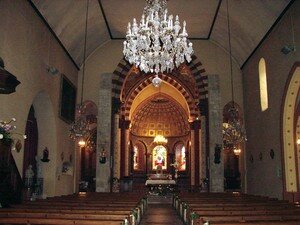 A
long nave, without column or pillar, is lit by seven windows: three on
the gate and four in the nave, this one is separated from the transept
by a large wall on which two powerful against forts with projections
contrebute the pillars of the bell-tower; this wall is bored of a
large arc triumphing in warhead doubled, heightened, and laterally of
two narrow passages arched high in gothic arch. The spans of the chorus
are arched, the power station, in broken cradle, the external ones in
compartments of edges. The dimension of the nave is 30 meters of the
gate to the chorus, and 12 meters width. Two small apses or absidioles,
arched like the principal one, flank this one, enlightened each one by
a window in semicircular arch.
A
long nave, without column or pillar, is lit by seven windows: three on
the gate and four in the nave, this one is separated from the transept
by a large wall on which two powerful against forts with projections
contrebute the pillars of the bell-tower; this wall is bored of a
large arc triumphing in warhead doubled, heightened, and laterally of
two narrow passages arched high in gothic arch. The spans of the chorus
are arched, the power station, in broken cradle, the external ones in
compartments of edges. The dimension of the nave is 30 meters of the
gate to the chorus, and 12 meters width. Two small apses or absidioles,
arched like the principal one, flank this one, enlightened each one by
a window in semicircular arch.
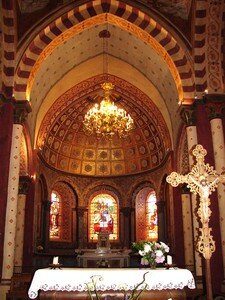 The
square of the transept, which communicates with the span of chorus by
an arcade in doubled warhead, is circumscribed by four strong square,
confined pillars imbedded columns and supporting an octagonal cupola on
horns. The arms of crossing, arched in cradle by a window, they are
separated from the chorus by simple arcs and square of the transept by
doubled arcs; all are in broken clotheshanger.
The
square of the transept, which communicates with the span of chorus by
an arcade in doubled warhead, is circumscribed by four strong square,
confined pillars imbedded columns and supporting an octagonal cupola on
horns. The arms of crossing, arched in cradle by a window, they are
separated from the chorus by simple arcs and square of the transept by
doubled arcs; all are in broken clotheshanger.
In the center of
transept crossing, a flagstone of gray color makes in kind separate the
heart from the body. Practical useful when the coffin of the late top
is posed. 
Pilasters of the Apse

 The
apse, in half dome, is surrounded - what is rare - of a blind arcade
with five bays in semicircular arch; two outsides blind, the three
others, are remade, splayed in contrary direction. The repercussions of
the arcs attenuate on pilasters.
The
apse, in half dome, is surrounded - what is rare - of a blind arcade
with five bays in semicircular arch; two outsides blind, the three
others, are remade, splayed in contrary direction. The repercussions of
the arcs attenuate on pilasters.
These pilasters, which, in the
apse, frame the stained glasses, are four, with capitals made up of
different reasons. These sculptures representing of the garlands, the
erudite spirals, made decorations of complicated interlacings.
They
seem to take again the symbolic system of the pillars of Avenas,
less complete. We find the 7 chakras with the flower corresponding
to the organs which they control, then a kundalini on the basis of the
mouth of a man. Sheets of acanthuses and pinks of Jericho supplement
decoration.
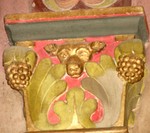
The vault saint-Anne
 This vault was built at the period of the beautiful Gothic style blazing, i.e. towards the beginning of XVth century.
This vault was built at the period of the beautiful Gothic style blazing, i.e. towards the beginning of XVth century.
The
vault is furnished with erudite veins, which come to resort to the four
angles in finely carved corbels which would reveal more details if they
were not covered with painting. The keystone is notched.
The vault
is lit by a remarkable opening divided by a central mullion, which
interlaces with those of slack with much of grace the figurines
circumvented in the warhead. It is a pity which time did not respect
the stained glass which furnished this opening, a simple window
replaces it.
The furnace bridge of the vault is out of wood. In a
niche dug with the top of the gate vault, one sees a large statue of
Holy Anne upright. On his left, one still finds the Marie Blessed
Virgin young girl, holding an open book and reading the Holy Scriptures
under the monitoring of his mother.
With the foot of the statues, a small cask on which one reads: “Brotherhood of saint Anne. 1866. ”
indicates that Saint Anne is the owner of the vine growers. Isn't it
the grand' mother of Jesus, whose first miracle was to change water
into wine with the wedding at Cana?
The recess of the vault
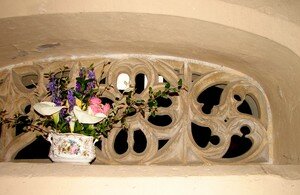 The recess is this depression in the partition wall of the nave of the
vault, depression whose wall is openwork by superb openings cut in the
stone. Its dimension is 2,20 m basic, 0,60 depth m. The word “enfeu” (recess)
comes from "enfouir" (to burn) and indicates a kind of funerary vault practised in a
wall, as one sees some in the catacombs.
The recess is this depression in the partition wall of the nave of the
vault, depression whose wall is openwork by superb openings cut in the
stone. Its dimension is 2,20 m basic, 0,60 depth m. The word “enfeu” (recess)
comes from "enfouir" (to burn) and indicates a kind of funerary vault practised in a
wall, as one sees some in the catacombs.
It is claimed that after the dead
of a Lord of Beaujeu, his body was exposed in this recess before the
burial. The shape, the size and especially the etymology of the word
"enfeu", to hide, to burn, seem to be probable.
http://www.beaujeu.com/histoire.html

/https%3A%2F%2Fprofilepics.canalblog.com%2Fprofilepics%2F1%2F1%2F116167.jpg)
/https%3A%2F%2Fstorage.canalblog.com%2F49%2F16%2F312499%2F14620054_o.jpg)
/https%3A%2F%2Fstorage.canalblog.com%2F53%2F18%2F312499%2F14151229_o.jpg)
/https%3A%2F%2Fstorage.canalblog.com%2F07%2F05%2F312499%2F14149867_o.jpg)
/https%3A%2F%2Fstorage.canalblog.com%2F11%2F35%2F312499%2F14149307_o.jpg)
/https%3A%2F%2Fstorage.canalblog.com%2F90%2F14%2F312499%2F14125247_o.jpg)


/https%3A%2F%2Fstorage.canalblog.com%2F12%2F98%2F137895%2F6624411_p.jpg)
/https%3A%2F%2Fstorage.canalblog.com%2F34%2F82%2F137895%2F27207854_p.jpg)
/https%3A%2F%2Fstorage.canalblog.com%2F32%2F37%2F137895%2F15872299_p.jpg)
/https%3A%2F%2Fstorage.canalblog.com%2F37%2F81%2F137895%2F15879822_p.jpg)